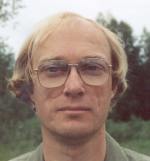 |
Ulf
Mjörnmark
Particle Physics Department of Physics |
 |
|
Activities
Services
|
ActivitiesPast and current projects1977-1978: SPSC/P 88, Polarized Jet CollaborationDuring the summer 1977 was I as a summer student at CERN, working in the Polarized Jet Collaboration. This I continued with after the stay CERN, when I started as a PhD student at Lund University. My work was part of the proposal to study spin effects in proton-proton reactions at the SPS accelarator at CERN, using a polarized atomic hydrogen jet target inside the vacuum pipe of the accelerator. My main contribution was a study of the reconstruction of the lambda from its decay into a proton and a pion. The proposal was refused, mainly because of the impact on the vacuum of the accelerator.1978-1983: R807, Axial Field spectrometer (AFS)The Axial Field Spectrometer (AFS) consisted mainly of a 2 pi Uranium-copper calorimeter, and a cylindrical drift chamber. These detectors were designed to study jet phenomena. Two NaI walls were positioned at opposite sides of the inetraction point making it possible to study direct photons and electrons. In addition, the AFS had a set of small drift chambers surrounding the beam pipes, used in glueball search, and a muon arm consisting of two proportional chambers with an iron wall inbetween. During the first years of operation was one of the uranium walls replaced by a cerenkov arm.During 1979-1980 did I work at CERN with the front end readout. Early 1981 did I return to Lund to work on my thesis on vector meson production in proton-proton and proton-antiproton interactions. 1983-1989: NA34, High Energy Lepton IOn Spectrometer (HELIOS)HELIOS was a fixed target experiment at the SPS accelerator at CERN. The apparatus was used in two slightly different setups, one for use with proton beams, the other for use with ion beams (oxygen and sulphur). HELIOS was designed for the purpose of studying production of electrons, muons and neutrinos. This required detectors capable of identifying leptons, and the associated events. The apparatus cosnisted of a wire target, and a silicon vertex detector. An electron spectrometer consisting of drift chambers, and a transition radiation detector. A muon spectrometer with proportional chambers, and a magnet. Hadron calorimeters were used to detect the associated event.I had the main responsibilty of the design and implementation of the data acquisition system. The front end electronics was in CAMAC, while the readout software was running on CPUs in VME crates. The CPUs were programmed in the language FORTH, of which a special dialect was developed within the collaboration. The data was transferred to a VAX750, for monitoring and tape writing. During the period 1983-1986 was I fellow at CERN, since then have I a position as research engineer at Lund University. 1989-2000 : DELPHI project.DELPHI is one of the four experiments at LEP (Large Electron Positron collider) at CERN. Working on the VSAT detector. The readout system of this detector was the main responsibility, including the trigger hardware,Local Trigger Supervisor (LTS), front end signal generation LURFB ( html , postscript ), and the front end readout of the data, as well as offline data quality checks. The data taking ended in 2000, when LEP was shutdown to allow for the building of LHC.1994-2007 : H1 project.H1 is one of the two e-p collider experiments at DESY. One of the Lund online projects in H1 is a radiation monitor system. This system monitors the backgroun d close to the interaction region and issues an alarm when the radiation exceeds a given level. The system is composed of radiation sensitive diodes, the analog signals from the diodes is digitized with a VME based FADC system. A hardware counter, RMAC (postscript), is used to issue the alarm. The complete system is controlled from a MacIntosh. The rate history can be seen in RMAC rates. Took part in the Data Acquisition of the Very Forward Proton Spectrometer (VFPS).1998- : ATLAS project.ATLAS is one of the experiments at proton-proton collider (Large Hadron Collider - LHC) at CERN. Participated in the design of the readout chip (DTMROC) and associated electronics for the TRT detector. Responsible for the ALFA subdetector data acquisition system at DESY testbeams. Took part in the design of the ALFA subdetector front end electronics.2003-2005 : ALICE project.ALICE is the experiment at LHC studying heavy ion collisons. Participated in developing a test setup using a robot to test ALTRO and PASA chips for the ALICE TPC (roughly 100 000 chips). Later used for tests of the PCA16 (improved version of PASA) for the LCTPC collaboration. It is also used for the SAMPA chip tests starting 2018.2007- : LCTPC project.LCPTC is a project within EUDET and AIDA EU funded projects to develop detectors for a future linear collider. Lund participates in the readout of a prototype TPC with GEMs (LCTPC). The electronics is based on the electronics used in the ALICE experiment at LHC. Responsible for test of electronics and data acquisition system of 10000 channels.This system is used since 2009 in a testbeam at DESY. Currently is a project to make the readout electronics 40 times smaller in progress, based on the SALTRO chip (ALTRO and PCA16 integrated in the same chip).2016- : ALICE project.ALICE is the experiment at LHC studying heavy ion collisons. Has been working on tests of the SAMPA chip that will replace the ALTRO electronics based readout of the TPC in the next upgrade of the detector.1990-2013 : Computer responsibility.Responsible for buying, installing and maintaining the computers at the division. |
 |


